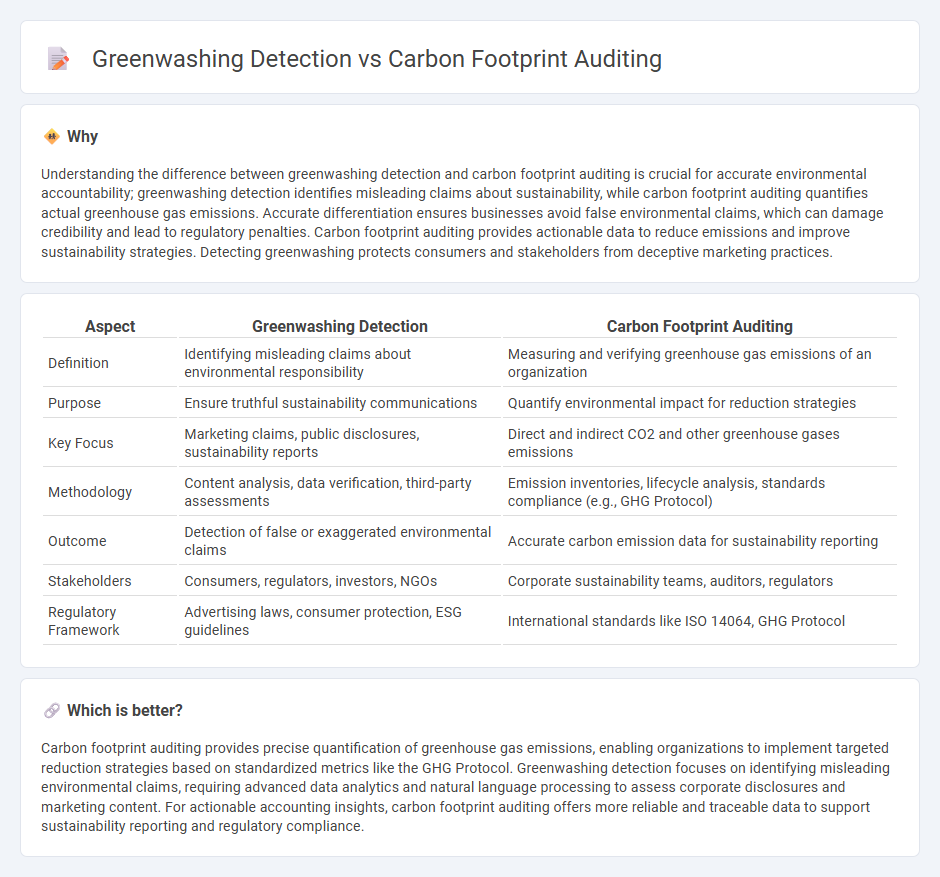
Greenwashing detection involves identifying deceptive claims about sustainability practices to prevent misleading stakeholders, while carbon footprint auditing measures an organization's actual greenhouse gas emissions to verify environmental impact. Accurate carbon accounting frameworks and third-party verification processes enhance transparency and accountability in corporate environmental reporting. Explore further details on how these methodologies protect sustainability integrity and drive genuine climate action.
Why it is important
Understanding the difference between greenwashing detection and carbon footprint auditing is crucial for accurate environmental accountability; greenwashing detection identifies misleading claims about sustainability, while carbon footprint auditing quantifies actual greenhouse gas emissions. Accurate differentiation ensures businesses avoid false environmental claims, which can damage credibility and lead to regulatory penalties. Carbon footprint auditing provides actionable data to reduce emissions and improve sustainability strategies. Detecting greenwashing protects consumers and stakeholders from deceptive marketing practices.
Comparison Table
| Aspect | Greenwashing Detection | Carbon Footprint Auditing |
|---|---|---|
| Definition | Identifying misleading claims about environmental responsibility | Measuring and verifying greenhouse gas emissions of an organization |
| Purpose | Ensure truthful sustainability communications | Quantify environmental impact for reduction strategies |
| Key Focus | Marketing claims, public disclosures, sustainability reports | Direct and indirect CO2 and other greenhouse gases emissions |
| Methodology | Content analysis, data verification, third-party assessments | Emission inventories, lifecycle analysis, standards compliance (e.g., GHG Protocol) |
| Outcome | Detection of false or exaggerated environmental claims | Accurate carbon emission data for sustainability reporting |
| Stakeholders | Consumers, regulators, investors, NGOs | Corporate sustainability teams, auditors, regulators |
| Regulatory Framework | Advertising laws, consumer protection, ESG guidelines | International standards like ISO 14064, GHG Protocol |
Which is better?
Carbon footprint auditing provides precise quantification of greenhouse gas emissions, enabling organizations to implement targeted reduction strategies based on standardized metrics like the GHG Protocol. Greenwashing detection focuses on identifying misleading environmental claims, requiring advanced data analytics and natural language processing to assess corporate disclosures and marketing content. For actionable accounting insights, carbon footprint auditing offers more reliable and traceable data to support sustainability reporting and regulatory compliance.
Connection
Greenwashing detection and carbon footprint auditing are interconnected processes crucial for verifying corporate environmental claims and ensuring transparency. Carbon footprint auditing provides accurate data on greenhouse gas emissions, which serves as a factual basis to identify instances of greenwashing where companies exaggerate or falsify their environmental impact reductions. Implementing rigorous carbon footprint audits enables accountants and auditors to detect misleading sustainability reports, promoting accountability and compliance with environmental regulations.
Key Terms
Emissions Reporting
Carbon footprint auditing involves the quantitative assessment of greenhouse gas emissions generated by an organization's operations, providing transparent and verifiable data crucial for sustainability reporting and regulatory compliance. Greenwashing detection scrutinizes claims made by companies to identify deceptive or exaggerated environmental benefits, ensuring the integrity of emissions reporting and protecting stakeholders from misinformation. Discover more about effective strategies to enhance emission transparency and trustworthiness in corporate sustainability efforts.
ESG Compliance
Carbon footprint auditing provides an accurate measurement of greenhouse gas emissions generated by organizations, enabling targeted reduction strategies and compliance with ESG standards. Greenwashing detection focuses on identifying misleading claims about environmental practices to ensure transparency and maintain stakeholder trust. Explore how these essential processes contribute to robust ESG compliance frameworks and sustainable business practices.
Sustainability Assurance
Carbon footprint auditing provides a quantitative assessment of greenhouse gas emissions, enabling organizations to identify reduction opportunities and track sustainability progress accurately. Greenwashing detection scrutinizes corporate claims to ensure transparency and prevent misleading information about environmental initiatives, strengthening stakeholder trust. Explore detailed methodologies and industry best practices to enhance your sustainability assurance efforts.
Source and External Links
Carbon Audit: A Practical Guide for Businesses - This guide provides a step-by-step approach to conducting a carbon audit, including data collection, emissions calculation, and identifying opportunities for reduction.
Carbon Footprint Verification Services - TUV SUD offers verification services for carbon footprints according to ISO standards, ensuring transparency and reliability in greenhouse gas emissions reporting.
Carbon Auditing Professional - This certification recognizes professionals who specialize in carbon reduction and GHG emissions programs, assisting organizations to minimize their carbon footprint.
 dowidth.com
dowidth.com